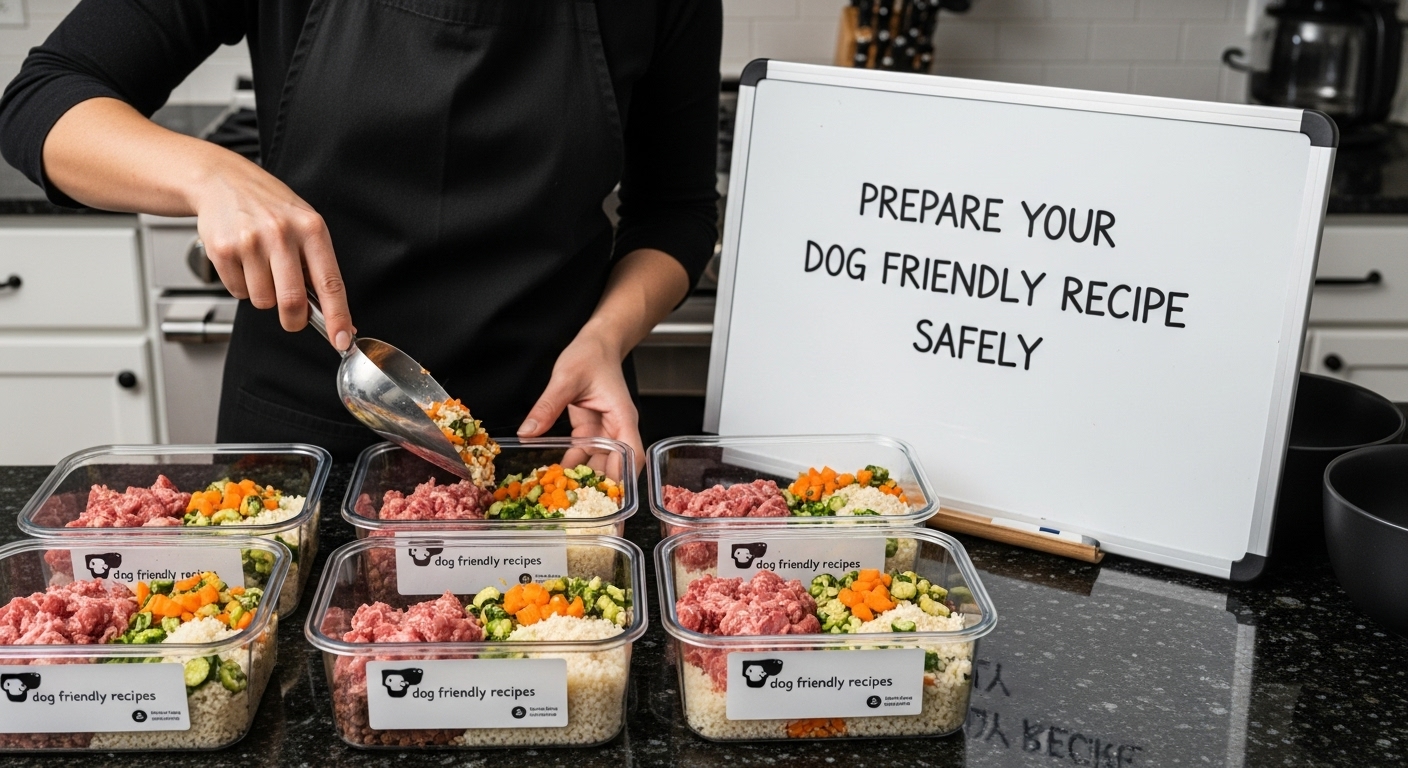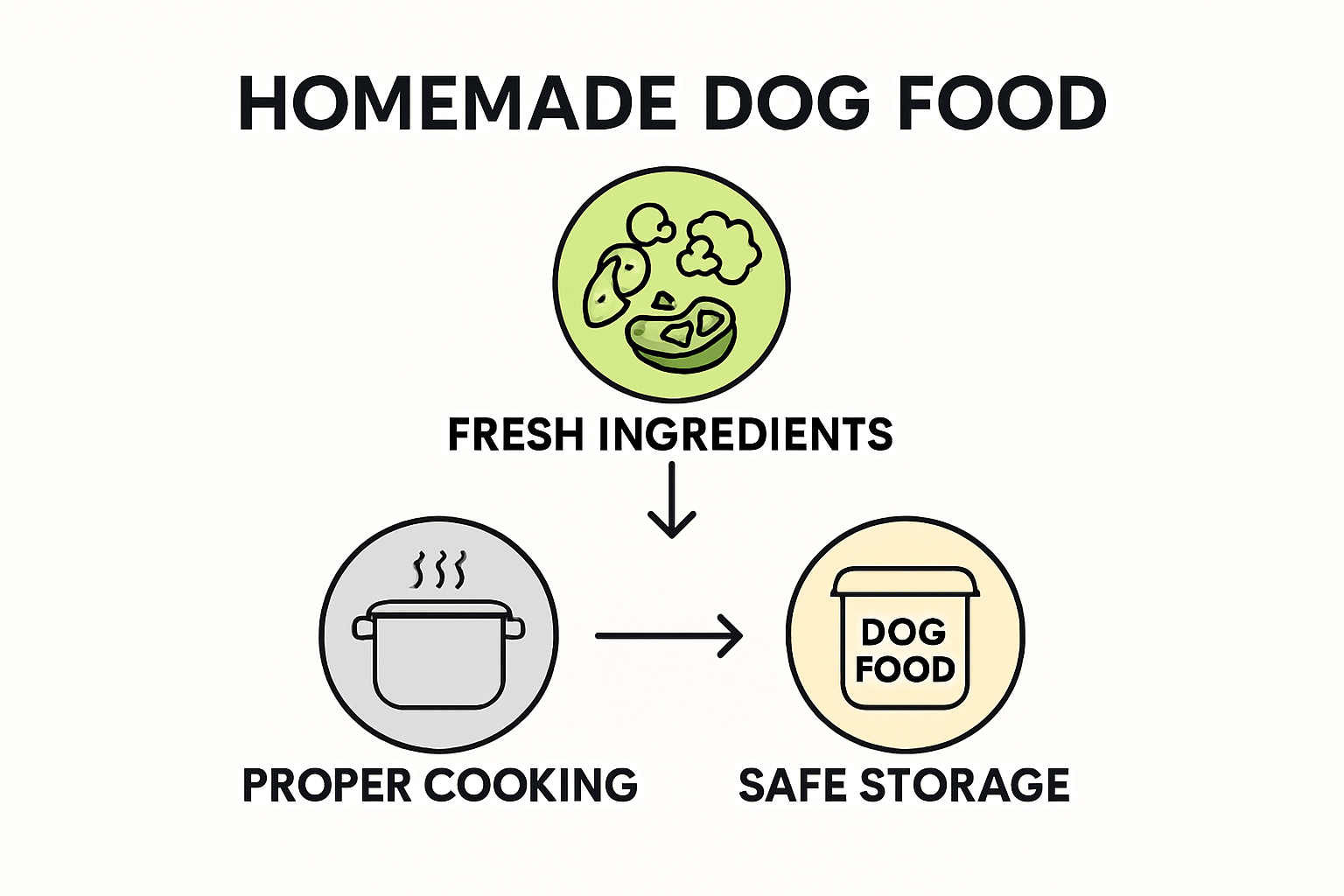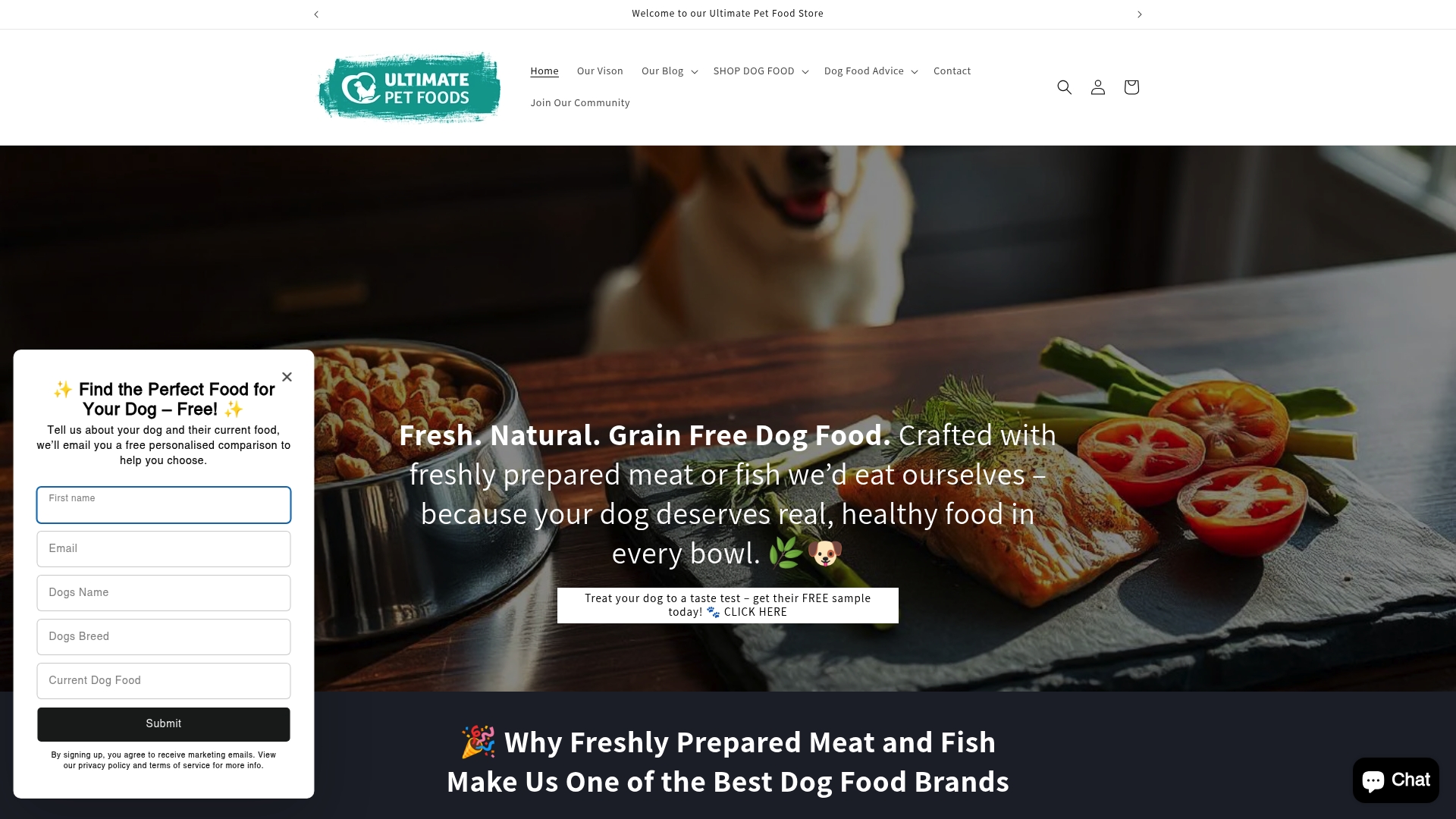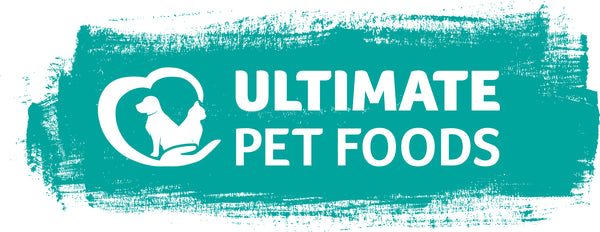
Wholesome Dog Friendly Recipes for Happy Pups
Share
Making homemade dog food sounds simple, right? Fresh ingredients and a bit of effort and your dog should be happy and healthy. But surprisingly, large breed dogs actually metabolise nutrients differently from smaller breeds, so the same meal can have very different effects. Most dog owners miss these crucial differences, which means even meals made with love might skip vital nutrition your dog truly needs.
Table of Contents
- Step 1: Assess Your Dog’s Dietary Needs
- Step 2: Gather Quality Ingredients For Recipes
- Step 3: Prepare Your Dog Friendly Recipe Safely
- Step 4: Cook And Combine Ingredients Effectively
- Step 5: Verify The Meal’s Nutritional Balance
- Step 6: Serve And Observe Your Dog’s Enjoyment
Quick Summary
| Key Point | Explanation |
|---|---|
| 1. Assess your dog’s unique needs | Evaluate factors like health, age, and activity to tailor their diet effectively. |
| 2. Use high-quality, human-grade ingredients | Select fresh proteins and vegetables free from harmful additives to ensure optimal nutrition. |
| 3. Prepare food safely and hygienically | Maintain cleanliness to avoid contamination and preserve the nutritional value of ingredients. |
| 4. Verify nutritional balance of meals | Consult a veterinary nutritionist for an accurate assessment of your dog’s dietary needs. |
| 5. Observe your dog’s response to meals | Monitor appetite and energy levels to ensure the recipes meet your dog’s preferences and health requirements. |
Step 1: Assess Your Dog’s Dietary Needs
Assessing your dog’s dietary needs is a critical foundation for creating wholesome dog friendly recipes that truly support their health and wellbeing. Every dog is unique, and understanding their specific nutritional requirements involves carefully evaluating several key factors that influence their dietary profile.
Begin by thoroughly examining your dog’s current health status, age, breed, weight, and activity level. Younger, active dogs require different nutrient ratios compared to senior or less mobile companions. Puppies need higher protein and calorie content to support growth, while older dogs might require lower calorie diets with joint-supporting nutrients. Breed size plays a significant role in determining nutritional needs dogs with larger frames typically metabolise nutrients differently from smaller breeds.
Consult with your veterinarian to conduct a comprehensive health assessment. They can provide invaluable insights into potential sensitivities, allergies, or specific health conditions that might necessitate dietary modifications. Some dogs might require specialised nutrition due to conditions like diabetes, kidney issues, or digestive sensitivities. Learn more about choosing the right dog food for your pet’s unique needs.
Pay close attention to your dog’s current diet and how they respond to different ingredients. Signs of dietary compatibility include:
- Consistent energy levels
- Healthy coat and skin condition
- Stable digestive processes
- Maintaining ideal body weight
- Clear eyes and alert demeanour
Observe any adverse reactions such as excessive scratching, digestive upset, or changes in coat quality. These could indicate potential food intolerances or nutritional imbalances that require careful dietary adjustments. Professional guidance ensures you create recipes that not only taste delicious but provide optimal nutrition tailored specifically to your dog’s individual requirements.
Step 2: Gather Quality Ingredients for Recipes
Gathering high-quality ingredients is the cornerstone of creating nutritious and delectable dog friendly recipes that will keep your furry companion healthy and satisfied. The ingredients you select will directly impact the nutritional value and palatability of the meals you prepare.
Human-grade ingredients are paramount when crafting homemade dog meals. Focus on sourcing fresh, minimally processed proteins such as lean meats like chicken, turkey, fish, and occasionally lean beef. These proteins should be free from added hormones and antibiotics, preferably sourced from reputable local suppliers or butchers who can confirm the meat’s quality and origin. Explore our comprehensive guide on reading dog food ingredients to understand what constitutes premium nutritional components.
Protein should form the foundation of your recipe, but equally important are complementary ingredients that provide essential nutrients. Incorporate dog-safe vegetables like sweet potatoes, carrots, green beans, and pumpkin. These not only add vital vitamins and minerals but also provide beneficial fibre that supports digestive health. Always ensure vegetables are thoroughly washed and prepared without seasoning or added salt.
When selecting ingredients, be mindful of potential allergens and toxic foods. Avoid onions, garlic, grapes, raisins, chocolate, and excessive amounts of dairy. Some dogs might have specific sensitivities, so introduce new ingredients gradually and observe your dog’s reaction. Keep a log of ingredients and any corresponding digestive or health responses.
Below is a checklist table to help you verify that your ingredient selection process meets nutritional and safety criteria for your dog’s meals.
| Ingredient Selection Criteria | Description |
|---|---|
| Fresh, high-quality proteins | Lean meats, free from hormones and antibiotics |
| Organic vegetables when possible | Minimally processed, thoroughly washed produce |
| No artificial preservatives/additives | Avoid chemicals and fillers |
| Trusted suppliers | Source ingredients from reputable outlets |
| Variety | Rotate ingredients for balanced nutrition |
| Free from toxic foods | Strictly avoid onions, garlic, grapes, etc. |
| Log responses to new ingredients | Track any digestive or health reactions |
Your ingredient verification checklist should include:
- Fresh, high-quality protein sources
- Organic vegetables when possible
- No artificial preservatives or additives
- Ingredients sourced from trusted suppliers
- Variety to ensure balanced nutrition
Remember that the quality of ingredients directly translates to the nutritional value of the meals you create. Investing time in selecting premium, wholesome components will contribute significantly to your dog’s overall health and happiness.
Step 3: Prepare Your Dog Friendly Recipe Safely
Preparing dog friendly recipes requires meticulous attention to safety, hygiene, and precise cooking techniques that preserve nutritional integrity while eliminating potential health risks. Your kitchen becomes a critical workspace where careful preparation can transform quality ingredients into nourishing meals for your canine companion.
Food safety begins with thorough preparation and sanitation. Start by washing all surfaces, cutting boards, and utensils with hot, soapy water before and after handling raw ingredients. Use separate cutting boards for meats and vegetables to prevent cross-contamination. Ensure all cooking surfaces and tools are thoroughly cleaned and sanitised before commencing recipe preparation. Learn more about creating the perfect feeding routine for your dog to complement your homemade meal preparation.
Cooking methods significantly impact the nutritional value and safety of dog recipes. Gentle cooking techniques are crucial for preserving nutrients and eliminating harmful bacteria. Baking, steaming, and poaching are preferred methods that maintain ingredient integrity. Cook meats thoroughly to an internal temperature of 75 degrees Celsius, ensuring all potential pathogens are destroyed. Avoid using excessive oils, salt, or seasonings that could harm your dog’s digestive system.
Portion control and storage are equally important aspects of recipe preparation. Once cooked, allow meals to cool completely before portioning. Use clean, airtight containers and refrigerate homemade meals promptly. Most prepared dog meals can be safely stored in the refrigerator for 3-4 days, or frozen for up to three months.
 Always label containers with preparation dates to track freshness.
Always label containers with preparation dates to track freshness.

Your recipe safety verification checklist should include:
- Clean and sanitised preparation area
- Thoroughly cooked proteins
- No added seasonings or harmful ingredients
- Proper cooling before storage
- Appropriate portioning and packaging
By following these precise preparation guidelines, you transform high-quality ingredients into safe, nutritious meals that support your dog’s health and happiness.
Use the following table as a safety and preparation checklist to ensure hygienic and effective cooking when making homemade dog food.
| Safety & Preparation Step | Requirement |
|---|---|
| Clean, sanitised preparation area | Wash surfaces, boards, and utensils before starting |
| Thoroughly cooked proteins | Cook meats to 75°C internal temperature |
| No added seasonings or harmful ingredients | Exclude salt, spices, and forbidden foods |
| Proper cooling before storage | Allow food to reach room temperature |
| Portioning and packaging | Use clean, airtight containers; label with dates |
| Safe storage duration | Refrigerate 3-4 days, freeze up to three months |
Step 4: Cook and Combine Ingredients Effectively
Cooking and combining ingredients effectively is the heart of creating nutritious and appealing dog friendly recipes. This step transforms individual components into a balanced, wholesome meal that meets your dog’s specific dietary requirements while tantalising their taste buds.
Protein should always be your primary cooking focus. Begin by cooking lean meats thoroughly, using methods that preserve maximum nutritional value. Gentle poaching or baking works exceptionally well, avoiding deep frying or adding unnecessary oils. Chicken, turkey, and fish can be prepared separately before mixing with complementary ingredients. Read our expert tips for successfully transitioning between different dog food preparations to understand how to introduce new recipes gradually.
Vegetable preparation requires a nuanced approach. Lightly steam or boil vegetables to maintain their nutritional integrity while making them more digestible for your dog. Root vegetables like sweet potatoes and carrots provide excellent nutritional benefits when cooked until soft but not mushy. Avoid overcooking, which can diminish vital nutrients. Chop vegetables into small, manageable pieces that are easy for your dog to consume and digest.
When combining ingredients, think about nutritional balance and palatability. Mix cooked proteins with prepared vegetables, ensuring even distribution. Consider adding small amounts of dog-safe grains like quinoa or brown rice for additional nutrition. Some dogs benefit from a sprinkle of bone broth or a small amount of pureed pumpkin to enhance flavour and digestive health.
Your ingredient combination verification checklist should include:
- Even distribution of proteins and vegetables
- Appropriate portion sizes
- Balanced nutritional profile
- Appealing texture and consistency
- No raw or undercooked ingredients
Remember that each dog is unique, so observe how your companion responds to different ingredient combinations. Some dogs might prefer certain textures or have specific preferences. Patience and experimentation are key to developing recipes that are both nutritionally sound and genuinely enjoyable for your furry friend.
Step 5: Verify the Meal’s Nutritional Balance
Verifying the nutritional balance of homemade dog meals is a critical step that ensures your furry companion receives comprehensive and appropriate nutrition. This process goes beyond simply combining ingredients and requires a methodical approach to understanding your dog’s specific dietary requirements.
Consulting with a veterinary nutritionist provides the most accurate assessment of your homemade recipe’s nutritional profile. These professionals can perform detailed analysis and recommend precise adjustments to meet your dog’s unique needs. They will evaluate protein, fat, carbohydrate, vitamin, and mineral content to confirm that your recipe provides a complete and balanced diet. Learn more about making informed choices for your dog’s nutrition to support your nutritional verification process.
At home, you can conduct preliminary nutritional assessments by tracking your dog’s physical responses and overall health indicators. Monitor key physiological signals such as coat shine, energy levels, muscle tone, and digestive regularity. These observable characteristics provide valuable insights into whether the homemade meals are meeting your dog’s nutritional requirements. Pay close attention to weight maintenance, as sudden gains or losses can indicate nutritional imbalances.
Utilise digital tools and nutritional calculators specifically designed for pet nutrition. Many veterinary nutrition websites offer calculators that help estimate the macro and micronutrient content of homemade recipes. These tools can provide rough estimates of protein, fat, and essential mineral percentages, helping you understand the overall nutritional composition of your prepared meals.
Your nutritional balance verification checklist should include:
- Consultation with veterinary nutritionist
- Tracking physical health indicators
- Use of digital nutritional calculation tools
- Regular weight monitoring
- Observation of energy and coat condition
Remember that nutritional needs evolve with age, activity level, and health status. What works perfectly for your dog today might require adjustment in the future. Maintaining flexibility and a commitment to ongoing nutritional assessment will help ensure your homemade dog meals continue to support your companion’s optimal health and vitality.
The following checklist will help you confirm that your dog’s homemade meals achieve proper nutritional balance for continued health.
| Nutritional Balance Check | Action |
|---|---|
| Veterinary nutritionist consultation | Seek expert evaluation of homemade recipes |
| Monitor physical health indicators | Observe coat shine, weight, muscle tone |
| Use digital nutrition tools | Estimate protein, fat, vitamin, and mineral content |
| Regular weight monitoring | Track for sudden gains or losses |
| Observe energy and coat condition | Assess vitality and skin health |
| Reassess as needs evolve | Adjust diet with age, activity, and health changes |
Step 6: Serve and Observe Your Dog’s Enjoyment
Serving homemade dog meals is more than simply presenting food. It represents the culmination of your careful preparation and a moment of connection with your canine companion. Presentation and portion control are key factors in ensuring a positive dining experience for your dog.
Begin by serving the meal at a comfortable temperature. Allow hot dishes to cool to room temperature, ensuring you can comfortably touch the food with your hand. Use clean, dedicated dog bowls that are appropriately sized for your pet. Smaller dogs require smaller portions, while larger breeds need more substantial meals. Explore our insights on creating the perfect feeding schedule to complement your meal preparation.
Observe your dog’s initial reaction carefully. Genuine enthusiasm includes a wagging tail, alert posture, and immediate interest in the meal. Dogs are individuals with unique preferences, so do not be discouraged if they are initially hesitant. Some dogs might need time to adjust to new flavours and textures. Introduce homemade recipes gradually, mixing them with their regular food to ease the transition.
Watch for specific enjoyment indicators during and after meals. Consistent eating, clean plate syndrome, and maintained energy levels suggest the recipe meets your dog’s nutritional and palatability requirements. Pay attention to potential adverse reactions such as digestive discomfort, reluctance to eat, or changes in stool consistency.
Your dog’s mealtime enjoyment verification checklist should include:
- Enthusiastic approach to meal
- Complete or near-complete consumption
- Stable digestive response
- Maintained energy levels
- No signs of discomfort or allergic reaction
Remember that creating the perfect homemade meal is an ongoing process of observation, adaptation, and love. Each recipe you prepare is an opportunity to strengthen the bond with your furry companion while providing optimal nutrition tailored specifically to their individual needs.
Want a Simple Way to Deliver Healthier, Happier Mealtimes?
You have learned that crafting wholesome, dog friendly recipes takes time and dedication. Selecting the right ingredients, preparing meals safely, and achieving balanced nutrition are often challenging especially if you have a small breed or a dog with sensitivities. What if you could guarantee the same quality nutrition without the daily hassle? Discover our grain free small breed dog food range, made with fresh, hypoallergenic ingredients and tailored for both picky eaters and sensitive stomachs.

Make each meal count and save valuable time by shopping at https://ultimatepetfoods.co.uk. Your pup deserves convenience without compromise on health. Explore our expertly crafted foods today and experience peace of mind with every bowl.
Frequently Asked Questions
What ingredients should I include in homemade dog food recipes?
When creating homemade dog food, focus on using human-grade ingredients like lean meats (chicken, turkey, fish) and dog-safe vegetables (sweet potatoes, carrots, green beans). Avoid harmful foods like onions, garlic, and chocolate.
How can I ensure my dog’s homemade meals are nutritionally balanced?
Consulting with a veterinary nutritionist is the best way to assess the nutritional profile of homemade meals. You can also use digital nutritional calculators to estimate the macro and micronutrient content of your recipes.
What cooking methods are best for preparing dog-friendly recipes?
Gentle cooking techniques are preferable, such as steaming, baking, or poaching, which help preserve nutrients while ensuring food safety. Avoid using excessive oils, salt, or seasoning in the cooking process.
How can I tell if my dog enjoys the homemade meals?
Observe your dog’s reaction during mealtime. Signs of enjoyment include an enthusiastic approach to the food, clean plates, and consistent energy levels. If your dog shows reluctance or discomfort, consider adjusting the recipe.
